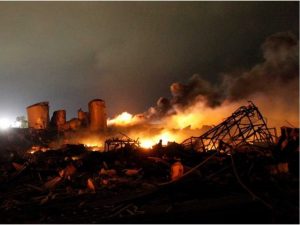 After a 3 month-long trial, jurors are finally deliberating on the fate of three rail workers accused of criminal neglegence when a “bomb train” carrying 73 cars of highly combustible crude oil derailed in the small Quebec town of Lac-Mégantic in 2013, killing 47 people.
After a 3 month-long trial, jurors are finally deliberating on the fate of three rail workers accused of criminal neglegence when a “bomb train” carrying 73 cars of highly combustible crude oil derailed in the small Quebec town of Lac-Mégantic in 2013, killing 47 people.
Three former employees of the Montreal, Maine and Atlantic Railway (MMA), Thomas Harding, 56, Richard Labrie, 59, and Jean Demaitre, 53, are being tried on 47 counts of criminal negligence causing death — one count for each of the victims of the rail disaster.
At around 1:00 am on July 6, 2013, the un-manned train began to roll down a hill toward the town after the lead locomotive was shut down due to a fire caused by mechanical problems. Shutting down the lead locomotive also disabled the backup brakes. The government (or “Crown,” this being Canada) is arguing that Harding (the engineer and sole crew member on the one-man train) didn’t set enough hand brakes on the train, Labrie, the rail traffic controller, didn’t confirm that enough handbrakes were set, and Demaitre, the manager of train operations, didn’t verify that the train was secure after the fire was extinguished and the lead locomotive was shut down.
I have written about this tragedy several times before, (including a detailed explanation of the Government’s investigative report here); specifically how the rail workers are being blamed for a railroad with a weak safety culture and a clear failure of management to establish and enforce safe procedures. MMA, an American-owned company, has since gone bankrupt.
As I said before, the them here is one that we’ve heard many times before — the tendency of those who have responsibility for a catastrophe to shift blame onto individual workers instead of identifying and addressing the root causes and systemic problems that could prevent future catastrophes.
Jury Instructed
The jury was instructed that this is not a joint trial of all three workers. The will have to analyze the evidence and determine “beyond a reasonable doubt” the three men are guilty and arrive at three separate verdicts. Interestingly, even Quebec Superior Court judge Gaétan Dumas acknowledged the Crown had a flimsy case against former MMA railway traffic controller Richard Labrie, 59, and ex-MMA operations manager Jean Demaître, 53. “I’m aware the evidence is weak,” Dumas told the court in the absence of the jury on Dec. 11. “However, it’s not up to me to evaluate it. That’s the jury’s job.”
The Case:
Among some of the interesting items that were revealed in the final days of the trial:

Training: Michael Horan, the former MMA assistant director of transportation, spent six days describing a work environment and that his team had received little material support from the U.S. head office. Horan, who was in charge of safety and training, testified he had no budget or training for how to teach safety standards.
Supervision: The Crown attempted to demonstrate that, as Harding’s supervisors the night of the disaster, Labrie and Demaître hadn’t done their jobs supervising Harding or ensure that the train was safely parked, but Demaître’s lawyer noted that there was no rule in effect in July 2013 that required locomotive engineers to inform their supervisors that a train had been properly secured, and that Demaître therefore had no reason to wonder if Harding had engaged a sufficient number of handbrakes.
MMA’s Safety Culture: A Transportation Safety Board report had found that MMA had a “weak safety culture that did not have a functioning safety management system to manage risks,” and that “no one individual, a single action or a single factor” caused the derailment. The judge ruled, however, that the report was inadmissible at the trial.
One Man Crews: The fact that MMA was running the trains, including Harding’s, with a one man crew was a major issue. Crown witness Randy Stahl, the MMA manager in charge of locomotive maintenance, testified that there was no difference in safety between trains operated by one person or two. But the jury had also heard expert evidence that “the only other railway in Quebec with a one-man crew operation, Quebec, North Shore & Labrador (QNSL) railway, had to respect 69 conditions imposed by Transport Canada before it could adopt them, while MMA had to comply with a single condition — the addition of a rearview mirror to the driver’s side of the lead locomotive.”
“If it doesn’t make a difference,” asked Charles Shearson, Harding’s attorney, “why did QNSL impose 69 conditions when they implemented a one-man crew? Why did they make engineers go through 10 days of training, and why did they make it mandatory for engineers to use [extra safety devices]?” he asked.
Since the derailment, one-man crews on trains carrying hazardous materials have been banned in Canada.
Communication: Former MMA locomotive engineer François Daigle told the court he knew there was a mechanical problem with the locomotive at the front of the train that derailed in Lac-Mégantic when it left the station on July 5, 2013, but he didn’t tell Harding, the person who operated it. Daigle told the court there were problems with all the MMA locomotives regularly, but nothing was ever done about it.
And Steve Jacques, a former rail traffic controller, testified that he was not aware the lead locomotive was defective when he gave Harding the green light to head down the line to Nantes, his final destination for the day.
Jacques said problems such as fires and overheating of locomotives were frequent and usually dealt with by the teams on the ground, without bothering the higher-ups. Under cross-examination, he acknowledged that Harding told him during the run to Nantes on July 5 that there were problems with the lead locomotive. Jacques never documented those problems nor relayed them to Labrie, the traffic controller who came on-shift after him. As long as the locomotive didn’t die, “it just keeps pushing,” Jacques testified. “If it’s rolling, it’s rolling.”
Brakes: The Crown’s case rested primarily on Harding’s failure to set enough hand brakes and perform a proper bake test, but
Shearson argued none of the MMA locomotive engineers or train conductors who testified knew exactly how many handbrakes were required to secure a fuel train in Nantes. During cross-examination, Shearson had asked those witnesses how many handbrakes they routinely applied to trains.
Several of them answered that a chart did exist indicating how many handbrakes to apply but said they generally used a formula: 10 per cent of the number of train cars plus two, which indicates the minimum number required. Callaghan, the Crown’s expert witness testified that at Nantes, that minimum number wouldn’t have been enough.
Shearson also noted in his closing arguments that other MMA employees showed a “pattern of non-perfect compliance” with the rules on brake tests. “We can’t hold people criminally responsible for not being perfect,” he said.
In conclusion, Shearson argued that one-person train crews, combined with substandard safety practices, led to a perfect storm that culminated in the tragedy.